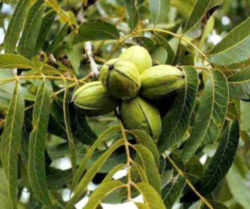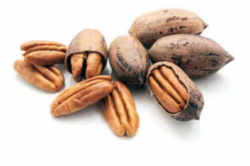
Texas Symbols
- State Resources
- » 50 States
- » Texas
- » Symbols
Texas State Health Nut
Pecan

(Juglandaceae Carya illinoensis)
Adopted on June 16, 2001.
The Pecan, (Juglandaceae Carya illinoensis,) was adopted on June 16, 2001 as the Texas State Health Nut when Governor Rick Perry signed Senate Concurrent Resolution No. 2.
One of the state's most universally enjoyed natural resources is the pecan; the nut of this majestic tree, which was deservedly named the state tree of Texas in 1919, is a delicious food product with considerable nutritional and health benefits; and Pecans contain protein, monounsaturated and polyunsaturated "healthy" oils, carbohydrates, fiber, iron, calcium, phosphorus, zinc, and potassium, as well as Vitamins A, B, C, and E and other antioxidants; scientific studies have also demonstrated that pecans can lower cholesterol, significantly contributing to improved cardiovascular health, while helping to reduce the risk of cancer; and a significant boon to the Lone Star State's economy, the pecan is grown commercially in more than 70 percent of the state's counties and Texas provides over a quarter of the nation's pecan crop.
Texas State Health Nut: Pecan

Pecans first became known to Europeans in the 16th century. The first Europeans to come into contact with pecans were Spanish explorers in what is now Mexico, Texas, and Louisiana.
Characteristics of the Pecan
Fruit
Large, oblong, brown, splotched with black, thin shelled nuts, 1 ? to 2 inches long, husks are thin, usually occur in clusters on trees. Mature in September and October.
A pecan, like the fruit of all other members of the hickory genus, is not truly a nut, but is technically a drupe, a fruit with a single stone or
pit, surrounded by a husk. The husks are produced from the exocarp tissue of the flower, while the part known as the nut develops from the endocarp
and contains the seed. The husk itself is aeneous, oval to oblong, 2.6-6 cm (1.0-2.4 in) long and 1.5-3 cm (0.59-1.18 in) broad. The outer husk is
3-4 mm (0.12-0.16 in) thick, starts out green and turns brown at maturity, at which time it splits off in four sections to release the thin-shelled
nut.
The seeds of the pecan are edible, with a rich, buttery flavor. They can be eaten fresh or used in cooking, particularly in sweet desserts, but also
in some savory dishes. One of the most common desserts with the pecan as a central ingredient is the pecan pie, a traditional southern US recipe. Pecans
are also a major ingredient in praline candy.
Tree
The pecan is native to Texas, it is the official state tree, it can be grown in every area of the state and it is a part of Texas tradition. All too frequently, the pecan is planted in anticipation of a large beautiful tree with heavy bearing. Unfortunately, there are times when this dream does not becomes a reality. A pecan tree can live with little or no care in much of Texas; however, if it is expected to look good as a landscape tree or if it is expected to produce high quality pecans every year, the pecan is a very high management crop.
See State Tree: Pecan (Juglandaceae Carya illinoensis)
Texas Concurrent Resolution
The Senate approved the Committee Substitute for Senate Concurrent Resolution (CSSCR) 2, which would designate the pecan "The Official Health Nut of Texas." The floor debate on CSSCR 2 was lengthy but light. After several humorous questions and observations from members of the Senate, Ratliff recognized Brown cautiously: "Sen. Brown, for what purpose, I'm afraid to ask."
"I thought Sen. Moncrief was the official health nut of the Senate," Brown replied.
Horseshoe Bay Sen. Troy Fraser, the sponsor of CSSCR 2, summed up the debate on the resolution: "It's a rather nutty bill."
CONCURRENT RESOLUTION
By: Fraser S.C.R. No. 2 Bill not drafted by TLC or Senate E&E.
WHEREAS, The State of Texas traditionally has recognized a variety of official state symbols as tangible representations of the proud spirit and heritage
of our state; and
WHEREAS, The bluebonnet, the lightning whelk, and the armadillo are examples of some natural specimens that serve to symbolize the great diversity
of the Texas landscape, while the state dish, chili, fittingly represents another aspect of our shared culture as Texans; and
WHEREAS, One of the state's most universally enjoyed natural resources is the pecan; the nut of this majestic tree, which was deservedly named the
state tree of Texas in 1919, is a delicious food product with considerable nutritional and health benefits; and
WHEREAS, Pecans contain protein, monounsaturated and polyunsaturated "healthy" oils, carbohydrates, fiber, iron, calcium, phosphorus, zinc, and potassium,
as well as Vitamins A, B, C, and E and other antioxidants; scientific studies have also demonstrated that pecans can lower cholesterol, significantly
contributing to improved cardiovascular health, while helping to reduce the risk of cancer; and
WHEREAS, A significant boon to the Lone Star State's economy, the pecan is grown commercially in more than 70 percent of the state's counties and Texas
provides over a quarter of the nation's pecan crop; and
WHEREAS, Nutritious and delicious, the pecan is an enduring and beloved aspect of the Texas landscape, and it is indeed appropriate that it be given
special recognition at this time; now, therefore, be it
RESOLVED, That the 77th Legislature of the State of Texas hereby designate the pecan as the Official State Health Nut of Texas.
06/16/2001 E Signed by the Governor
Senate Concurrent Resolution No. 2, 77th Legislature, Regular Session (2001)
Texas Law
Texas state pecan
Texas State Health Nut: Pecan (nuts in husks ripening on tree)
Jerry A. Payne
USDA Agricultural Research Service, Bugwood.org
The pecan was named the official health nut of the State of Texas by Senate Concurrent Resolution and is not, therefore, listed in the Texas Statutes.
Interestingly, the State Tree of Texas was adopted by Senate Bill No. 317 in 1919 and, therefore, written into law.
Only a few of Texas' myriad symbols were actually adopted by an act of the legislature and written into the Texas Statutes.
Taxonomic Hierarchy: Pecan
Kingdom: Plantae - Plants
Subkingdom: Tracheobionta - Vascular plants
Superdivision: Spermatophyta - Seed plants
Division: Magnoliophyta - Flowering plants
Class: Magnoliopsida - Dicotyledons
Subclass: Hamamelididae
Order: Juglandales
Family: Juglandaceae - Walnut family
Genus: Carya Nutt. - hybrid hickory
Species; Carya illinoinensis (Wangenh.) K. Koch - pecan







